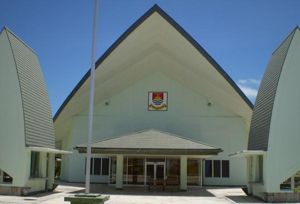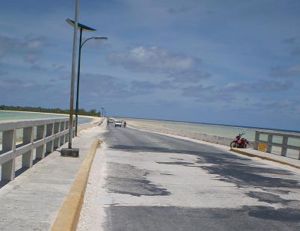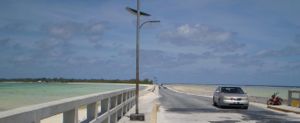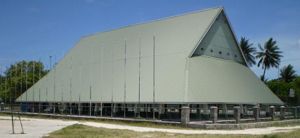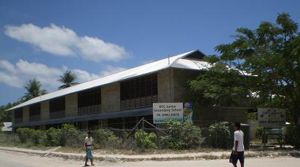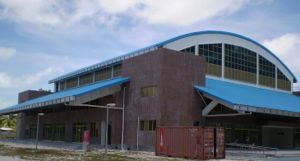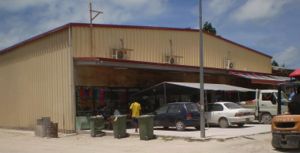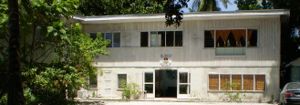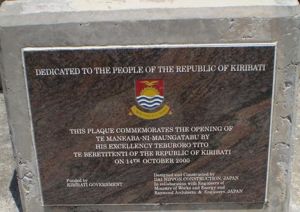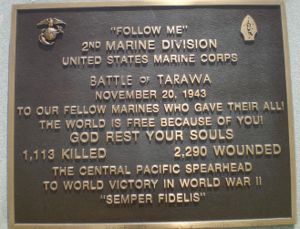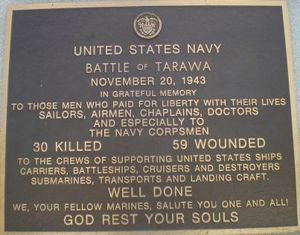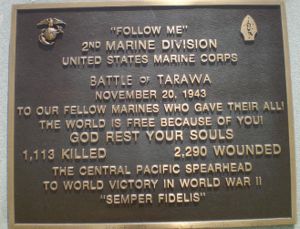Life in Kiribati/Buildings
From WikiEducator
Contents
- 1 House of Parliament in Kiribati
- 2 Bariki-Betio Dai Nippon Causeway
- 3 The Longest Causeway in Kiribati
- 4 The Kiribati National Youth Council Maneaba
- 5 The Junior Secondary School at Betio
- 6 The Betio Sports Complex
- 7 Commercial Store in Betio
- 8 The Office of the Public Service
- 9 The Openning of the New House of Parliament Plaque
- 10 The United States Plaque
- 11 Memorial US Navy Plaque for the 2nd World War Heroes
- 12 The US Marines Commemoration Plaque for the Fallen Heroes During the Battle of Tarawa
House of Parliament in Kiribati
This is the House of Parliament in Kiribati. It is situated at Ambo on South Tarawa and was recently built by a Japanese company. The House of Parliament in Kiribati sits about at least twice a year. The term of office for representatives is 4 years. The most current term starts this month. The last general election was completed on 30th August 2007. The recent provision has 46 members of Parliament. Each island is represented and the bigger constitutiencies have 2 for medium ones and 3 for big ones. The big constituancies include Kiritimati, South Tarawa, Betio, and Rural Tarawa. The President is elected by the people of Kiribati from amongst a group of presidential candidates. A president can be for only 3 terms after which he/she is not allowed by law to become a president thereafter. Return to Life_in Kiribati.Bariki-Betio Dai Nippon Causeway
This is the longest causeway in Kiribati. It links up Betio and South Tarawa. This causeway was built again by a Japanese Company called Dai Nippon. With the causeway completed, travelling between Betio and urban Tarawa became so much more convenient and fast. Betio is the centre for trade and business between Tarawa and foreign exporters like Australia and New Zealand. The sea port located on Betio is a gateway to foreign Countries, fishing companies, foreign boats, tourists, and general merchandise trade and commercial activities. The causeway breaks in between to allow sea water and boats to access both sides of the sea. This provides a convenient passage through which fishing boats can easily traverse the ocean and the lagoon paths as well as fishing areas on Tarawa or at nearby islands - especially close by Maiana island which is around 30 km away from Tarawa. Return to Life_in Kiribati.The Longest Causeway in Kiribati
The Dai Nippon Causeway links up Betio and South Tarawa. Before the causeway was built travelling between these two places involve a ferry that leaves each station at every half hours. Workers on each side have to extensively travel each day to and from their houses to their work stations. Now with the causeway in place transporting containers of food and general merchandise, and general travel has become so much easier and faster. The causeway was built by Dai Nippon Construction Company from Japan. The built involve piling sand up from the adjacent lagoon sea bed obtained from Betio and nearby lagoon floors. Return to Life_in Kiribati.The Kiribati National Youth Council Maneaba
This is a modern Maneaba. It is of permanent material but is designed from the local structure of a traditional Maneaba. This is basically a huge meeting and gathering house. The traditional Maneaba is meant to be a meeting and decision making house for village and island functions. The new ones are used to hold meetings, workshops, and large gatherings such as weddings and festivals especially during the independence cerebrations. This KNYC maneaba is located on Bairiki - the seat of Government. As such it provides a public hall for large gatherings and is conveniently placed in the capital, which makes it accessible for big and public forums. Return to Life_in Kiribati.The Junior Secondary School at Betio
This is a junior secondary school. This is the type built by AusAID in early 2000. There is a JSS on every island. This offers basic education from years 7 to years 9. At the end of JSS an I-Kiribati student would have undergone the 9 years of free and compulsory basic education. This JSS building is located on Betio where a large part of the population is concentrated and on a very small piece of land mass. The roll in this JSS could well exceed a thousand. There are other JSS on outer islands all serving the same functions. Return to Life_in Kiribati.
